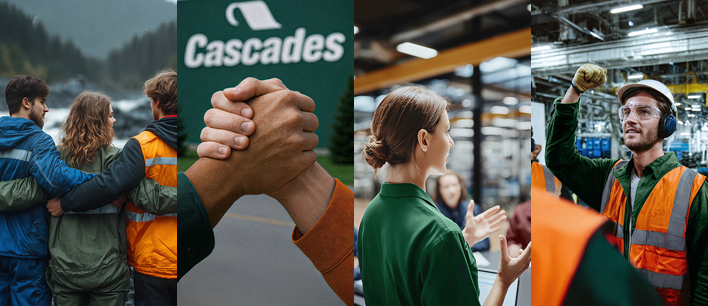We all go through by place in a week: the grocery store. Some of us go there just one time and hope we don't have to go back; for others, it's a daily appointment! No matter what our shopping habits are or how often we visit, as soon as we walk through the doors, we know that we will have dozens of choices to make. If your choice of packaging was not part of it before, after reading this article, it will be a thing of the past because during Quebec’s Waste reduction week, Cascades wants you to develop this new reflex: analyzing packaging. To make it more concrete, we accompanied two employees, Gabriel Arguin, environmental consultant, and Marie-Eve Chapdelaine, director of sustainability, in their shopping and their thought process.
Involved in waste management at work as well as in their personal lives, the expression "3RV-B" (for reduce, reuse, recycle, value, bury) is part of their mutual language. Equipped with their reusable grocery and produce bags they make their entrance.
Their geographic reality: they don't have a bulk or zero-waste grocery store nearby, they frequent farmers' markets (including the one Cascades has set up for its employees and the Kingsey Falls community) and they have a small vegetable garden at home. Faced with the following products, here are the decisions they made.
The tomatoes
Five options are available to them: loose individually, loose in clusters, in clusters in a plastic bag, in a clamshell plastic container (with lid) or in a plastic container covered with a plastic film.
Gabriel : Gabriel: Obviously, I prefer tomatoes in bulk to avoid managing a package at the end of its life. I also prioritize the seasonal tomatoes available at my public market. They can be kept longer because they are fresher. On the other hand, for occasional out-of-season needs, I sometimes opt for cherry tomatoes with a hole in the shell packaging. As the planting season approaches, reusing these clamshell packages provides ideal containers to start them. In case of overflow, the packaging is more easily recycled.
Marie-Eve: Same for me. For cherry tomatoes, I admit I had a doubt between the shells and the containers with film. The ones with film allow to reduce the amount of plastic because it replaces the lid. However, I know that the film goes in the trash (it's a flexible plastic, but it doesn't stretch). The question is: do I opt for a package with more plastic but that is recyclable or a package with less plastic but a disposable film? I opt to reduce what ultimately goes into the trash, so my choice: the tray with a lid.
Clementines
Three options are available to them: wooden box, cardboard box or in a net.
Gabriel: Marie-Eve: Others use wooden crates rather than kindling to start fires. Nonetheless, pure wood should not be used to make single-use packaging.
Marie-Eve: Marie-Eve: Others use wooden crates rather than kindling to start fires. Nonetheless, pure wood should not be used to make single-use packaging.
The Milk
Six options available to them: three pockets in a bag, gabled carton with spout, gabled carton with pouring cap, a plastic jug in plastic bottles or returnable glass.
Gabriel: This one is tricky. As my family has grown, so has our milk consumption. I used to opt for the gable carton and spout, but to cut costs, we now buy the 4L size in plastic bags, although they are not recycled... However, we do reuse the milk bags for all-purpose bags (snacks, freezing, etc.)!
Marie-Eve: To meet the needs of a family of five, I also opt for milk bags. I don't reuse the bags; I already have enough for storage and freezing. Plus, I wash them! I also reuse the milk pouches, as well as cereal and chip bags, as garbage bags or all-purpose bags. So we never buy garbage bags.
Non-fresh vegetables
Three options available to them: frozen in a soft bag, frozen in a stand-up bag or canned.
Gabriel: It's not that simple! Perhaps a life cycle analysis could help us decide which option is the most eco-friendly. For my part, I prefer flexible plastic packaging because it contains more vegetables. This way, I avoid over-packaging and I get a bigger portion. I think that even though the aluminum in cans is infinitely recyclable, a lot of energy is needed to recycle it. The carbon footprint must surely be to the advantage of frozen food, as long as the contents of the package are not wasted due to a too long period in the freezer.
Marie-Eve: Most of the time, I choose frozen vegetables in soft bags. These stretchy bags can be collected in a bag of bags and then put in the recycling bin (in Canada). This is not the case with stand-up bags.
What is your trick to waste less?
Marie-Eve: Go to the grocery store often. There was a time when, because of time constraints or to limit our travel, we would do big groceries and fill the fridge. It was so full that we couldn't its contents and forgot things. Now we prefer to do smaller grocery runs but more often.
Gabriel: Grocery shopping with a list and tight management of the fridge inventory. We recently got a vacuum sealer and we really like it because it causes much less waste for everything that goes into the freezer. We still have to keep a tight inventory of what we have.
What kind of packages do you dislike?
Gabriel: The bags of sauces and purees that are in multi-layered packages made of plastic and aluminum with a small cap. Our boys are asking for them and they are unfortunately fast and convenient so yes, guilty, these packages are generated in our household...
Marie-Eve: Oh, there are many! I don't buy cheese sticks. I feel like I'm buying more plastic than cheese. Same goes for drinkable yogurts, especially those assembled in individual packages. I don't buy cookies that are packaged in small sizes (ex. six packs in a box). In general, cookies are over-packaged as most packaging is not recyclable except for the cardboard.
The important thing is to be aware of the items we buy, their packaging and their composition. Limiting over-packaging is important, but we also need to think about food safety, as in the case with Halloween candy. Personal limitations also causes people to prefer one product over another. For example, a person may find that a product is more suitable for their needs as it is already cut, cooked or discounted, without considering the packaging. Ideally, let's make a collective effort to choose packaging that can be recycled rather than single-use packaging. You should know that there are often alternatives that are more respectful of the planet.
This article is meant to be entertaining and informative. The decisions of our two employees are based on their judgment and their knowledge of waste management. They applied the principles of the 3RVB (reduce, reuse, recycle, recover, bury) and made decisions according to their own reality. Photos have been added to enhance the text. They are representative of the products available on the shelves at the time of writing and are not intended to prejudice the brands featured.


